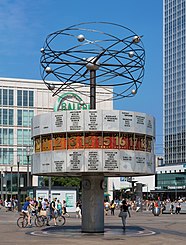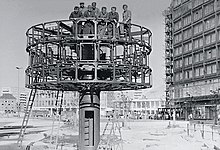World clock (Alexanderplatz)
The world time clock on Alexanderplatz in Berlin 's Mitte district (also: Urania world time clock ) is a modular clock system with a symbolic representation of the world. On its metal rotunda it contains the names of 146 places as well as an additional entry on the date line. Since it was set up in 1969, the ten-meter-high world time clock has been a popular meeting place for Berliners and tourists in the German capital. The world clock has been a listed building since July 2015.
history
The world clock was ceremoniously presented to the public on September 30, 1969 - in advance of the 20th anniversary of the GDR , on which the Berlin television tower was also opened. This manifested itself roughly in the completion of the extensive redesign of Alexanderplatz in the sense of socialist modernism and a generous urban planning, as a result of which "the Alex" was about four times as big as before the Second World War . The symbolic power and pride of the world clock, which is also accepted in everyday language by all parts of the population, is shown, among other things, in the publication of postage stamps and a special coin .
The world clock was designed by the designer Erich John , as a member of the planning group for the redesign of Berlin's Alexanderplatz under the direction of Walter Womacka . At the time, Erich John taught as a lecturer for design (later product design ) at the University of Fine and Applied Arts in Berlin. John also directed the nine month construction work. The construction of the world time clock was a team effort by around 120 specialists from various trades , including the Coswig gear factory and the on-site blacksmith and metal sculptor Hans-Joachim Kunsch . Due to the great popularity of the world clock, it is assumed that John would have received a design award in the GDR for his design back then - if it had existed in 1969. So he got it in 1982 for another product.

The idea for the clock came in 1968 while redesigning a Urania column (or weather column ) that was discovered during demolition work in 1966 as part of the redesign of the formerly war-torn Alexanderplatz. In the East Berlin press in 1969, the building was referred to as the "Urania column with the world clock". The name comes from Urania , the muse of astronomy from Greek mythology . A world time clock for Leipzig designed by John in 1977 was not realized for cost reasons.
Between October and December 1997 the clock was renovated for 350,000 marks (adjusted for purchasing power in today's currency: around 243,000 euros) under the responsibility of Hans-Joachim Kunsch as a metal restorer. During the redevelopment, city names such as Leningrad in Saint Petersburg and Alma Ata in Almaty were updated. The name Bratislava was changed to Pressburg despite diplomatic protests from Slovakia . 20 new cities were added and the assignment of cities to time zones changed (example Kiev ). Cities added only in 1997 include Jerusalem and Tel Aviv .
In 2018, the designer and creator of the watch, Erich John, transferred the advertising and marketing rights to a Berlin start-up company .
Description and function
A three-part cylinder with a base area of 24 corners and sides is mounted on a 2.7-meter-high column with a 1.5-meter diameter above the stone mosaic in the form of a compass rose embedded in the floor . Each of the 24 pages corresponds to one of the 24 main time zones on earth. The ten meter high world time clock has a mass of 16 tons. The names of important cities in the time zone are milled into the aluminum . An hour ring rotates in this cylinder. On this the hours, marked in color, move through the time zones. A simplified representation of the solar system with planets (spheres) and their orbits represented by steel circles rotates above the world clock once a minute . In total, the clock is ten meters high.
The clock's technology is located two meters below the square in a room that is around 5 meters by 5 meters and around 1.90 meters high. The electric motor driving the planetary system and the gearbox date from the GDR era. A converted Trabant transmission , together with a ball bearing from the Rothe Erde company, has performed the most important function since commissioning , namely the drive of the hour ring.
In the course of the renovation in 1997, the then aurotech GmbH took over the technical-electrical part. The electric motor for the hour ring has been replaced with a new gear motor that turns the hour ring five percent faster than the time runs out. Twelve cams were attached to the hour ring to the exact hour. The ring therefore reaches the hour around three minutes earlier and the associated cam hits a switch that switches off the motor. After the three minutes have elapsed - the full hour has been reached - the control computer bridges the switch based on the signal from the time signal transmitter Mainflingen near Frankfurt until the cam has left it - the motor runs until the next cam. This means that no runtime errors can accumulate . The brief stopping of the hour ring is imperceptible to the viewer - but it is with time-lapse recordings .
Social relevance
The Urania world time clock has been a popular meeting place and meeting point on Berlin's Alexanderplatz since the mid-1970s.
On May 12, 1983 MPs from the Greens, Petra Kelly , Gert Bastian and three other MPs, unfurled a banner in front of the world clock that read “The Greens - Swords to Plowshares ” and were arrested shortly afterwards. After their release, they met with GDR civil rights activists , which was tolerated because the Greens rejected NATO's double decision .
During the political change and precisely at the celebrations of the 40th anniversary of the GDR on October 7, 1989, many opposition people gathered in the vicinity of the world clock and from there formed a peaceful protest march to the Palace of the Republic and with shouts like " We are the people " further to the Gethsemane Church . During the march, and especially afterwards, there was massive violence by the police and state security, with a total of 1200 arrests. 33 days later the Berlin Wall fell .
Others
The Urania world clock plays a central role in the music video for the track Run To The Sun by the British synth-pop duo Erasure . In the video from 1994 singer Andy Bell can be seen dancing through an animation in the middle of the world clock.
For the 50th anniversary in 2019, the right of exploitation , e.g. for replicas as souvenirs, was assigned.
literature
- Heike Schüler: world time clock and Wartburg steering wheel. Erich John and the GDR design. Jaron Verlag, Berlin 2019, ISBN 978-3-89773-860-7 .
Web links
- Kerstin Decker: 50 years of Alex: Everyone knows the world time clock, nobody knows its inventor - nobody had the intention of erecting this crazy clock on the Alex. And the designer Erich John almost never designed them. Der Tagesspiegel , online portal, April 14, 2019. Retrieved April 16, 2019 .
Individual evidence
- ↑ Helmut Caspar: Trouble with the world clock on the Alex. City names are incorrect. In: Märkische Allgemeine , 24/25. December 1997.
- ^ Uwe Aulich: Monument protection for GDR houses on Alex. In: Berliner Zeitung , July 14, 2015, p. 15.
- ↑ References of the company Kunsch Metallbau GbR ( Memento of November 10, 2013 in the Internet Archive ) accessed on July 3, 2013.
- ↑ a b c d Information from the designer of the world clock, Erich John .
- ↑ BZ Berlin : This is how the world clock ticks on Alexanderplatz , article from July 10, 2019, accessed on September 30, 2019
- ↑ Pressburg or Bratislava? Slovakia protests against world clock. In: Berliner Zeitung , December 20, 1997, accessed on November 21, 2018.
- ↑ Freshly polished: the world clock will soon be turning. In: Berliner Zeitung , December 12, 1997, accessed on July 3, 2013.
- ↑ The world clock is now ticking correctly again. In: taz , December 20, 1997, accessed November 21, 2018
- ↑ Berliner Zeitung : World clock at Alexanderplatz. Berlin start-up receives advertising rights , article from November 11, 2018, accessed on September 30, 2019
- ↑ World clock - meeting point with inner life. In: Berliner Zeitung , January 30, 2007, accessed on November 21, 2018.
- ↑ Udo Baron: Cold War and Hot Peace. Lit Verlag, Münster 2003, ISBN 3-8258-6108-2 , p. 188
- ↑ Video animation 1994 ( Memento from April 11, 2014 in the Internet Archive )
- ↑ The world clock is marketed. In: Der Tagesspiegel , November 12, 2018, accessed on November 24, 2018
- ↑ World clock on Alex: 50th year of life of a design icon. In: Berliner Lokalnachrichten , November 14, 2018, accessed on November 24, 2018
- ↑ The world clock comes to the souvenir shops. In: Berliner Abendblatt , November 21, 2018, accessed on November 24, 2018
Coordinates: 52 ° 31 ′ 16.2 " N , 13 ° 24 ′ 47.9" E




